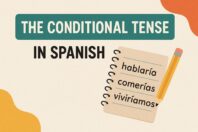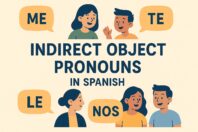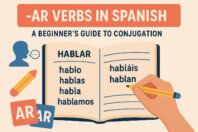Porque vs Por qué: How To Never Confuse Them Again

Get our free email course, Shortcut to Conversational.
Have conversations faster, understand people when they speak fast, and other tested tips to learn faster.
More infoMixing up porque vs por qué is something that happens to almost all beginners when they first start learning Spanish:
In all languages, there are certain homophonous (similar sounding) words that tend to cause confusion for beginners. As a native English speaker, it’s hard to imagine how difficult it is for language learners to tell the difference between there/their, to/too, buy/by/bye, and so on.
Today, we’re make sure that you never confuse porque and por qué again.
In addition to this, we will explain two new variations (porqué and por que), and how you can start using them.
Stay tuned.
Porque – “Because”
This word, written without the accent mark, is used as the equivalent to because in English.
As a single word, it’s used to express a cause or motive, and can even be replaced by similar expressions such as “ya que”, or “dado que”.
For example:
- Martha could not come because it was too far for her – Martha no pudo venir porque era muy lejos para ella
- I was dirty because I was cleaning the attic – Yo estaba sucio porque estaba limpiando el ático
- I didn’t call or answer you because I was busy working – No te llamé ni te contesté porque estaba ocupado trabajando
- We didn’t talk too much because it was late and I had to leave – No hablamos mucho porque era tarde y tenía que irme
(or “no hablamos mucho ya que era tarde y tenía que irme”)
In the last example, you can see how porque and ya que are interchangeable, and the same goes for using dado que.
Por qué – “Why”
The most important points to remember about using por qué is that they are two separate words, and that the qué contains an accent.
If you forgot these two points, then people will assume that you are saying porque. Although this sounds blatantly obvious, mixing up the two is a bad habit that some beginners (and even native speakers) tend to pick up.
Por qué is the equivalent to why in English, and it’s used the exact same – whether you are asking questions, or inquiring about reasons or motives.
In most cases, por qué is preceded by a question mark, with the exceptions of why being in the middle of a sentence as we’ll see below.
Here we have some examples:
- Why didn’t you ask earlier? – ¿Por qué no preguntaste antes?
- Why are you always so late? – ¿Por qué llegas tan tarde siempre?
- I wonder why they decided to come, after hearing what happened – Me pregunto por qué decidieron venir, después escuchar lo que pasó
Now that we’ve clarified the differences when it comes to using porque v por qué, we are going to explain two new variations which have a different purpose.
Before I introduce the next two variations, I have to admit that some native speakers don’t use them – either due to ignorance or confusion, but it’s still worth knowing them in case you see them in text, hear them from a native speaker, or want to impress with your next-level Spanish skills.
El Porqué – “The Reason”
This might look exactly like the previous variation we covered, but porqué, written as a single word and with an accent mark, is used as a noun.
Using el porqué is a common way to ask for “the why” or “the reason” for something to happen or simply exist.
Here are a few example sentences:
- We simply don’t know the reason behind his actions – Simplemente no sabemos el porqué detrás de sus acciones
- You never told me why when you left – Nunca me dijiste el porqué cuando te fuiste
- I need you to explain the reason behind all of that – Necesito que me expliques el porqué de todo eso
Por que – “For Which”
I have to admit, this last one is a little weird.
This variation, used without accent marks, is typically used as the equivalent “for which” in English, although it can also be translated as “why”, “whereby” and “which is why”.
In most cases, por que is used as the “for which/why/whereby/which is why” that connects two actions in the same sentence.
The strange thing about using por que, in this instance, is that it’s very common for native Spanish speakers (including me) to replace it with one of the interchangeable options below, which all translate as the exact same thing.
- Por el cual (Masculine form)
- Por la cual (Feminine form)
- Por el que (Masculine form)
- Por la que (Feminine form)
For example, if you wanted to say:
- That is exactly the reason why I wanted you to call me.
We could translate this to Spanish using three options:
- Esa es exactamente la razón por que quería que me llamaras
- Esa es exactamente la razón por la que quería que me llamaras
- Esa es exactamente la razón por la cual quería que me llamaras
(sidenote: we use “la que” / “la cual” because “razón” is a feminine word.)
The second instance where you will see this variation is when using verbs that require the use of por, and are then naturally followed by que.
- Preocuparse por + que (to worry about)
- Luchar por + que + (to fight for)
- Interesarse por + que (to be interested in)
- Velar por + que (to make sure of)
- Optar por + que (to opt for)
- Estar ansioso por + que (to be anxious for)
Let’s looks at some examples:
- El doctor debía velar por que sus pacientes se recuperaran antes de salir del hospital – The doctor had to make sure that his patients recovered before leaving the hospital
- Ella se preocupa por que estés bien – She worries about you being good
- Debido a las lesiones de los jugadores, el entrenador optó por que se reprogramara el juego – Due to the injuries of the players, the coach opted for the game to be postponed.
- Lucho por que haya paz en el mundo – I fight so that there is peace in the world
Don’t worry if you can’t get your head around understanding this por que variation right away. As I said before, it’s not overly common for native speakers to use this, and even being aware of this variation puts you ahead of most Spanish learners.
Now – let’s practice.
Porque vs Por Qué Exercises
The following exercises should be fairly straightforward – simply add either porque or por qué.
1.- ¿________ crees que la temporada terminó así?
(Why do you think the season ended like that?)
2.- No entiendo ________ seguimos haciendo esto.
(I don’t understand why we keep doing this)
3.- Salí temprano ________ tenía mucho trabajo que hacer.
(I left early because I had a lot of work to do)
4.- Preparé varios platos ________ no sé les gusta comer.
(I prepared several dishes because I don’t know what you guys like to eat)
5.- No recuerdo ________ traje todo esto.
(I don’t remember why I brought all of this)
6.- ¿ ________ no has terminado tu trabajo aún?
(Why haven’t you finished your work yet?)
7.- Avísame si necesitas algo ________ no sé cuando vuelva a salir.
(Let me know if you need anything because I don’t know when I’m going out again)
8.- Están molestos ________ no hay suficiente para todos
(They are upset because there’s not enough for everyone)
9.- Cambiaron la programación ________ tenían demasiados invitados
(They changed the schedule because they had too many guests)
10.- ¿ ________ no vienes con nosotros?
(Why don’t you come with us?)
11.- Creo que me fue mal ________ no estudié suficiente
(I think I did poorly because I didn’t study enough)
12.- ¿ ________ no bebes algo de agua?
(Why don’t you drink some water?)
Answers
1.- ¿Por qué crees que la temporada terminó así?
2.- No entiendo por qué seguimos haciendo esto.
3.- Salí temprano porque tenía mucho trabajo que hacer.
4.- Preparé varios platos porque no sé qué les gusta comer.
5.- No recuerdo por qué traje todo esto.
6.- ¿Por qué no has terminado tu trabajo aún?.
7.- Avísame si necesitas algo porque no sé cuando vuelva a salir.
8.- Están molestos porque no hay suficiente para todos.
9.- Cambiaron la programación porque tenían demasiados invitados.
10.- ¿Por qué no vienes con nosotros?.
11.- Creo que me fue mal porque no estudié suficiente.
12.- ¿Por qué no bebes algo de agua?.



